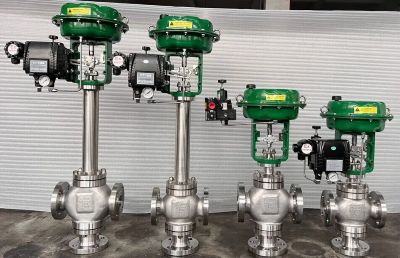


Understanding 3-Way Globe Control Valves: Functionality, Operation, and Industrial Applications
Precise fluid flow control is crucial across many industries such as power generation, chemical processing, HVAC, and water treatment. The 3-way globe control valve is a key component widely used where fluid mixing or diversion is necessary. Its versatile design and accurate modulation make it essential for complex flow control tasks.
A 3-way globe valve has three ports—commonly labeled A, B, and AB (or M)—allowing it to mix two fluid streams into one or divert a single stream into two separate paths. Its name comes from the globe-shaped body and the internal mechanism where a movable plug or disc regulates flow through a stationary seat.
There are three main configurations of 3-way globe valves, each serving distinct functions:
Mixing Valve: Two inlets (A and B) feed into the valve, which blends the streams inside and sends a mixed flow out through a single outlet (AB). This is commonly used in HVAC systems for mixing hot and cold water or in chemical processes for blending fluids.
Diverting Valve: A single inlet (A) flows into the valve, which directs fluid to one of two outlets (B or AB) based on the plug’s position. This setup is ideal for switching flow between processing lines or directing coolant to different equipment.
Universal Valve: This flexible design allows the valve to perform both mixing and diverting, with any two ports acting as inlets or outlets. It’s suitable for complex thermal systems or chemical dosing applications.
The valve’s internal plug moves linearly inside the globe body, modulating flow paths as directed by an actuator. Depending on the valve type and actuator, the plug adjusts flow proportions (mixing mode) or switches flow between outlets (diverting mode).
Manual: Simple handwheel or lever operation for basic systems.
Pneumatic: Air pressure actuates the valve, offering quick response for industrial processes.
Electric: Provides precise, programmable control, perfect for automated systems.
Hydraulic: Used where high force is needed, such as in high-pressure environments.
Actuators can include positioners and sensors for enhanced automation and accuracy.
Versatility: Combines mixing and diverting functions, reducing the need for multiple valves.
Compact: Saves space by replacing two valves with one.
Precision: Globe design ensures accurate flow control and tight shut-off.
Durability: Available in materials like stainless steel and bronze to suit harsh conditions.
Maintenance-Friendly: Modular design allows easy servicing and reduces downtime.
HVAC: Balances heating and cooling flows for energy efficiency.
Chemical Processing: Enables accurate blending and flow diversion in reactors.
Power Plants: Controls steam and water flow in boilers and auxiliary systems.
Food & Beverage: Supports cleaning processes and ingredient mixing.
Pharmaceuticals: Provides precise dosing and sanitary flow control.
Oil & Gas: Manages fluids in refining and blending processes.
Choosing the right 3-way globe valve involves considering material compatibility, flow capacity (Cv), pressure and temperature ratings, and the appropriate actuation method for system automation. Regular inspection, lubrication, and calibration are vital to maintaining performance and preventing issues such as plug wear or actuator failure.
The 3-way globe control valve is a versatile and efficient solution for managing complex fluid flows in many industries. By offering precise mixing and diverting capabilities within a compact design, it improves system flexibility, reduces installation complexity, and supports advanced automation.
With proper selection and maintenance, these valves contribute significantly to the reliability and efficiency of industrial fluid control systems.Know more about Google SEO Directory
